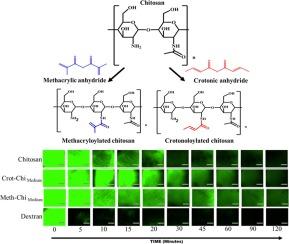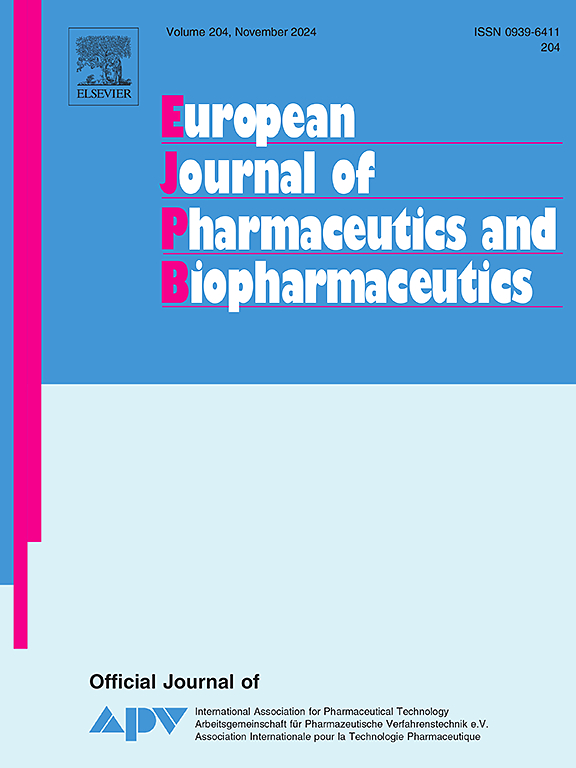用甲基丙烯酰基和巴豆酰基对壳聚糖进行官能化处理,以增强其粘附性。
IF 4.4
2区 医学
Q1 PHARMACOLOGY & PHARMACY
European Journal of Pharmaceutics and Biopharmaceutics
Pub Date : 2024-11-06
DOI:10.1016/j.ejpb.2024.114575
引用次数: 0
摘要
粘液黏性聚合物对于延长药物在粘膜表面的滞留时间至关重要。本研究的重点是通过壳聚糖与巴豆酸酐和甲基丙烯酸酐的反应合成新型衍生物并确定其特性。利用质子-核磁共振波谱和傅立叶变换红外光谱确认了所得衍生物的结构。结果表明,取代度对壳聚糖衍生物随 pH 值变化的溶解度曲线和电泳迁移率起着至关重要的作用。通过对壳聚糖溶液进行喷雾干燥,制备出了微颗粒,并利用荧光流动研究和拉伸试验对其粘附性进行了评估,结果表明改性衍生物在绵羊鼻粘膜上的粘附性有所改善。利用疟原虫进行的体内急性毒性研究和利用体外粘膜上皮细胞模型 Caco-2 细胞系进行的 MTT 试验表明,新型衍生物没有细胞毒性。这些发现强调了壳聚糖定制化学修饰在加强经粘膜给药方面的潜力。本文章由计算机程序翻译,如有差异,请以英文原文为准。

Functionalisation of chitosan with methacryloyl and crotonoyl groups as a strategy to enhance its mucoadhesive properties
Mucoadhesive polymers are crucial for prolonging drug retention on mucosal surfaces. This study focuses on synthesising and characterising novel derivatives by reacting chitosan with crotonic and methacrylic anhydrides. The structure of the resulting derivatives was confirmed using proton-nuclear magnetic resonance spectroscopy and Fourier-transform infrared spectroscopy. It was established that the degree of substitution plays a crucial role in the pH-dependent solubility profiles and electrophoretic mobility of the chitosan derivatives. Spray-drying chitosan solutions enabled preparation of microparticles, whose mucoadhesive properties were evaluated using fluorescence flow-through studies and tensile test, demonstrating improved retention on sheep nasal mucosa for modified derivatives. Acute toxicity studies conducted in vivo using planaria and in vitro using MTT assay with the Caco-2 cell line, a model of the mucosal epithelium in vitro, showed that the novel derivatives are not cytotoxic. These findings emphasise the potential of tailored chitosan chemical modifications for enhancing transmucosal drug delivery.
求助全文
通过发布文献求助,成功后即可免费获取论文全文。
去求助
来源期刊
CiteScore
8.80
自引率
4.10%
发文量
211
审稿时长
36 days
期刊介绍:
The European Journal of Pharmaceutics and Biopharmaceutics provides a medium for the publication of novel, innovative and hypothesis-driven research from the areas of Pharmaceutics and Biopharmaceutics.
Topics covered include for example:
Design and development of drug delivery systems for pharmaceuticals and biopharmaceuticals (small molecules, proteins, nucleic acids)
Aspects of manufacturing process design
Biomedical aspects of drug product design
Strategies and formulations for controlled drug transport across biological barriers
Physicochemical aspects of drug product development
Novel excipients for drug product design
Drug delivery and controlled release systems for systemic and local applications
Nanomaterials for therapeutic and diagnostic purposes
Advanced therapy medicinal products
Medical devices supporting a distinct pharmacological effect.

 求助内容:
求助内容: 应助结果提醒方式:
应助结果提醒方式:


